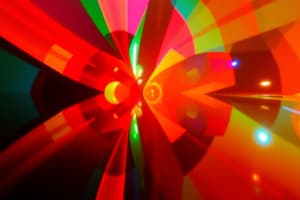Podcast
Questions and Answers
What is the reason for the bending of light as it passes from one medium to another?
What is the reason for the bending of light as it passes from one medium to another?
- The difference in the refractive indices of the two mediums
- The difference in the angle of incidence and refraction
- The difference in the wavelength of light in different mediums
- The difference in the speed of light in different mediums (correct)
What is the formula that describes the relationship between the angles of incidence and refraction?
What is the formula that describes the relationship between the angles of incidence and refraction?
- n1 cos(θ1) = n2 cos(θ2)
- n1 sin(θ1) = n2 sin(θ2) (correct)
- n1 sec(θ1) = n2 sec(θ2)
- n1 tan(θ1) = n2 tan(θ2)
What is the minimum angle of incidence required for total internal reflection to occur?
What is the minimum angle of incidence required for total internal reflection to occur?
- Equal to the critical angle
- Greater than the critical angle (correct)
- Less than the critical angle
- There is no minimum angle of incidence
What type of reflection occurs when light is reflected at the same angle as the angle of incidence?
What type of reflection occurs when light is reflected at the same angle as the angle of incidence?
What is the law of reflection?
What is the law of reflection?
What is the purpose of total internal reflection in optical fibers?
What is the purpose of total internal reflection in optical fibers?
What type of mirror produces a virtual image?
What type of mirror produces a virtual image?
What is the term for the line perpendicular to the surface at the point of incidence?
What is the term for the line perpendicular to the surface at the point of incidence?
Flashcards are hidden until you start studying
Study Notes
Light Refraction
- Refraction is the bending of light as it passes from one medium to another with a different optical density.
- It occurs because light travels at different speeds in different mediums.
- The amount of bending depends on the angle of incidence, the angle of refraction, and the refractive indices of the two mediums.
- Snell's Law describes the relationship between the angles of incidence and refraction:
n1 sin(θ1) = n2 sin(θ2)wheren1andn2are the refractive indices of the two mediums, andθ1andθ2are the angles of incidence and refraction, respectively.
Total Internal Reflection
- Total internal reflection occurs when light hits a medium with a lower refractive index at an angle greater than the critical angle.
- The critical angle is the angle of incidence above which total internal reflection occurs.
- Total internal reflection is used in optical fibers to transmit data over long distances.
Light Reflection
- Reflection is the change in direction of light when it hits a surface and bounces back.
- There are two types of reflection:
- Specular reflection: Light is reflected at the same angle as the angle of incidence, creating a mirror-like effect.
- Diffuse reflection: Light is scattered in different directions, creating a soft, non-mirror-like effect.
Laws of Reflection
- The law of reflection states that the angle of incidence is equal to the angle of reflection.
- The normal to the surface is the line perpendicular to the surface at the point of incidence.
- The incident ray, reflected ray, and normal all lie in the same plane.
Mirrors
- Mirrors work by reflecting light using specular reflection.
- There are two types of mirrors:
- Plane mirrors: Flat mirrors that produce a virtual image.
- Spherical mirrors: Curved mirrors that can produce either a real or virtual image, depending on the object's position.
Light Refraction
- Refraction occurs when light passes from one medium to another with a different optical density, causing it to bend.
- Light travels at different speeds in different mediums, resulting in refraction.
- The amount of bending depends on the angle of incidence, the angle of refraction, and the refractive indices of the two mediums.
- Snell's Law describes the relationship between the angles of incidence and refraction:
n1 sin(θ1) = n2 sin(θ2).
Total Internal Reflection
- Total internal reflection occurs when light hits a medium with a lower refractive index at an angle greater than the critical angle.
- The critical angle is the angle of incidence above which total internal reflection occurs.
- Total internal reflection is used in optical fibers to transmit data over long distances.
Light Reflection
- Reflection is the change in direction of light when it hits a surface and bounces back.
- There are two types of reflection: specular reflection and diffuse reflection.
- Specular reflection occurs when light is reflected at the same angle as the angle of incidence, creating a mirror-like effect.
- Diffuse reflection occurs when light is scattered in different directions, creating a soft, non-mirror-like effect.
Laws of Reflection
- The law of reflection states that the angle of incidence is equal to the angle of reflection.
- The normal to the surface is the line perpendicular to the surface at the point of incidence.
- The incident ray, reflected ray, and normal all lie in the same plane.
Mirrors
- Mirrors work by reflecting light using specular reflection.
- There are two types of mirrors: plane mirrors and spherical mirrors.
- Plane mirrors produce a virtual image.
- Spherical mirrors can produce either a real or virtual image, depending on the object's position.
Studying That Suits You
Use AI to generate personalized quizzes and flashcards to suit your learning preferences.




